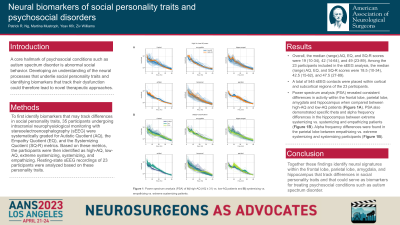Neural biomarkers of social personality traits and psychosocial disorders
Neural Biomarkers of Social Personality Traits and Psychosocial Disorders
Friday, April 21, 2023


Patrick Ng, BS, BA (he/him/his)
Medical Student
Harvard Medical School
Cambridge, Massachusetts, United States
ePoster Presenter(s)
Introduction: A core hallmark of psychosocial conditions such as autism spectrum disorder is abnormal social behavior. Developing an understanding of the neural processes that underlie social personality traits and identifying biomarkers that track their dysfunction could therefore lead to novel therapeutic approaches.
Methods: To first identify biomarkers that may track differences in social personality traits, 35 participants undergoing intracranial neurophysiological monitoring with stereoelectroencephalography (sEEG) were systematically graded for Autistic Quotient (AQ), the Empathy Quotient (EQ), and the Systemizing Quotient (SQ-R) metrics. Based on these metrics, the participants were then identified as high-AQ, low-AQ, extreme systemizing, systemizing, and empathizing. Resting-state sEEG recordings of 23 participants were analyzed based on these personality traits.
Results: Overall, the median (range) AQ, EQ, and SQ-R scores were 19 (10-34), 42 (14-64), and 49 (23-89). Among the 23 participants included in the sEEG analysis, the median (range) AQ, EQ, and SQ-R scores were 18.5 (10-34), 42.5 (15-62), and 47.5 (27-89). A total of 545 sEEG contacts were placed within cortical and subcortical regions of the 23 participants. Power spectrum analysis (PSA) revealed consistent differences in activity within the frontal lobe, parietal lobe, amygdala and hippocampus when compared between high-AQ and low-AQ patients. PSA also demonstrated specific theta and alpha frequency differences in the hippocampus between extreme systemizing vs. systemizing and empathizing patients. Alpha frequency differences were found in the parietal lobe between empathizing vs. extreme systemizing and systemizing participants.
Conclusion : Together these findings identify neural signatures within the frontal lobe, parietal lobe, amygdala, and hippocampus that track differences in social personality traits and that could serve as biomarkers for treating psychosocial conditions such as autism spectrum disorder.
Methods: To first identify biomarkers that may track differences in social personality traits, 35 participants undergoing intracranial neurophysiological monitoring with stereoelectroencephalography (sEEG) were systematically graded for Autistic Quotient (AQ), the Empathy Quotient (EQ), and the Systemizing Quotient (SQ-R) metrics. Based on these metrics, the participants were then identified as high-AQ, low-AQ, extreme systemizing, systemizing, and empathizing. Resting-state sEEG recordings of 23 participants were analyzed based on these personality traits.
Results: Overall, the median (range) AQ, EQ, and SQ-R scores were 19 (10-34), 42 (14-64), and 49 (23-89). Among the 23 participants included in the sEEG analysis, the median (range) AQ, EQ, and SQ-R scores were 18.5 (10-34), 42.5 (15-62), and 47.5 (27-89). A total of 545 sEEG contacts were placed within cortical and subcortical regions of the 23 participants. Power spectrum analysis (PSA) revealed consistent differences in activity within the frontal lobe, parietal lobe, amygdala and hippocampus when compared between high-AQ and low-AQ patients. PSA also demonstrated specific theta and alpha frequency differences in the hippocampus between extreme systemizing vs. systemizing and empathizing patients. Alpha frequency differences were found in the parietal lobe between empathizing vs. extreme systemizing and systemizing participants.
Conclusion : Together these findings identify neural signatures within the frontal lobe, parietal lobe, amygdala, and hippocampus that track differences in social personality traits and that could serve as biomarkers for treating psychosocial conditions such as autism spectrum disorder.
